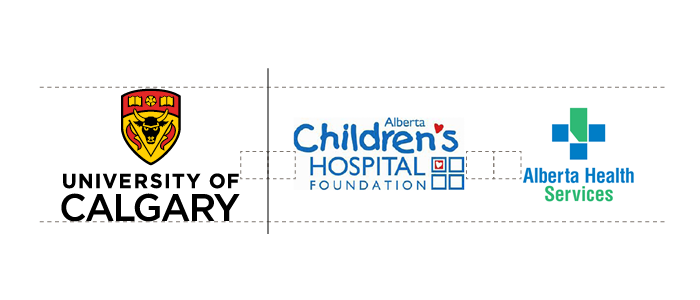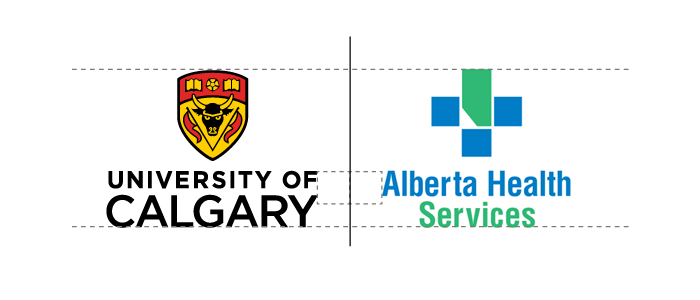Partners
We value our our community partnerships and show our support in many ways – it's important to identify our connection clearly.
Logos
Equal partnerships
When the university is presented in partnership with other organizations, it is important to understand the nature of the agreement. When there is an equal partnership, the university and partner logo(s) should be the same height, and the university logo should be placed on the left. The space between the logos should be equal to twice the width of the capital "A" in the university's logo. A 0.5pt black line can be placed between the logos, as shown below.
UCalgary lead partner
When the university is in partnership with other organizations but is the lead of the initiative, the partner logos must be a maximum of 70 per cent of the vertical height of the university logo. Logos must be placed at the minimum allowable spacing referenced below. A single vertical line centred on the minimum clear space may be placed between the university logo and the others.

An example of a logo grouping when the university is the lead partner
Branding
In all partnerships, promotion and event materials should feature UCalgary colours, fonts and imagery guidelines. (Alone or in combination with partner branding) This includes:
- Websites
- Social media graphics
- Ads
- Posters and print materials
- Pull-up banners
- Swag
- Etc.
This does not apply to events and initiatives where UCalgary is only a sponsor.
Questions? Contact brand@ucalgary.ca

Example of an ad featuring a partnership between UCalgary and AHS using our brand.
Centres and institutes
UCalgary is home to or partner in numerous centres and institutes, many of which have become nodes of research excellence and achieved national or international prominence. Note: According to the university’s Research Centre and Institute policy, ‘institute’ and ‘centre’ are interchangeable terms. In conversation and written materials, ‘institute’ is often used to stand for both.
University institutes exist entirely within the administrative structure of the university. They are multi-disciplinary, crossing the domains of multiple faculties and academic departments.
For example:
Faculty or department institutes exist within the bounds of a single faculty or department, though they sometimes explore cross-disciplinary connections. In some cases, they are named in such a way that they indicate a broader scope (e.g. ‘Calgary Centre…’ or ‘Canadian Centre’), but this does not necessarily formalize a mandate broader than that defined by the university.
For example: (note this list does not include all institutes)
- Calgary Institute for the Humanities
- Canadian Centre for Advanced Leadership in Business
- Centre for Corporate Sustainability
- Centre for Entrepreneurship and Innovation
- Centre for Environmental Engineering and Research
- Centre for Military, Security and Strategic Studies
- Centre for Research in the Fine Arts
- Clinical Simulation Learning Centre
- Calgary Institute for the Humanities
- Informatics Research Centre
- Institute for Advanced Policy Research
- Institute for Quantum Science and Technology
- Institute for Security, Privacy and Information Assurance
- Language Research Centre
- Sport Injury Prevention Research Centre
- Trico Foundation Social Entrepreneurship Centre
- Westman Centre for Real Estate Studies
Partnership institutes are constituted as formal partnerships with legal entities external to the university, including other universities, government agencies, and legally independent institutes.
In the case of the Cumming School of Medicine, for example, the core research institutes are a partnership between the Cumming School of Medicine and Alberta Health Services (Calgary Zone). These institutes encompass activities in all three areas of education, research and service to society and serve as the umbrella organization for research groups, ensuring high quality research programs span the continuum of bench to bedside. The institutes also contribute to the enhanced delivery of healthcare in a setting of inquiry and education, including the development of networks of care for Alberta Health Services (Calgary Zone) and southern Alberta. Institute directors are appointed jointly by the dean of the Cumming School of Medicine and the president and CEO of Alberta Health Services.
For example:
- Advancing Canadian Wastewater Assets (ACWA) (with City of Calgary)
- Alberta Children’s Hospital Research Institute (with AHS)
- Arnie Charbonneau Cancer Institute (with AHS)
- Calvin, Phoebe and Joan Snyder Institute for Chronic Diseases (with AHS)
- City Building Design Lab (with Calgary Municipal Land Corporation)
- Hotchkiss Brain Institute (with AHS)
- Innovate Calgary (with Government of Alberta)
- Libin Cardiovascular Institute of Alberta (with AHS)
- McCaig Institute for Bone and Joint Health (with AHS)
- Quantum City (with Government of Alberta)
- Urban Alliance (with City of Calgary)
For the majority of centres and institutes on campus, the only visual identity required is that of the university.
These entities exist within the university framework and support its research agenda. Their value comes from the contributions of University of Calgary researchers and the infrastructure provided them by the institution. The results of the research conducted through these channels are presented under the auspices of the university and carry the weight of the university name.

Examples of UCalgary institute branding
An exception to this brand approach is for partnership institutes.
Because these institutes are created in a neutral space between two or more partnering organizations, there is often a need to develop a unique identity and then tie the partnering entities to it. In many cases, the rationale for doing this involves a need to promote the institute actively as a possible destination for support from private donors. In these cases, the visual identity treatment is subject to policies and procedures in place at each partnership organization, so it is worth having a conversation at the outset to determine the most logical course of action.

Examples of partnership institute identities
Some centres and institutes have developed unique identifiers.
Unique identifiers are marks within the UCalgary brand which allow centres, institutes and initiatives to have a distinct identity that aligns with their external communication objectives, while remaining aligned to our visual identity. This treatment can be applied to both internal and partnership institutes, but its use is considered on a case by case basis. Learn more.

Examples of institutes with unique identifiers
Alumni Affinity Communities
Find out more about logo options and usage for Affinity Communities.




